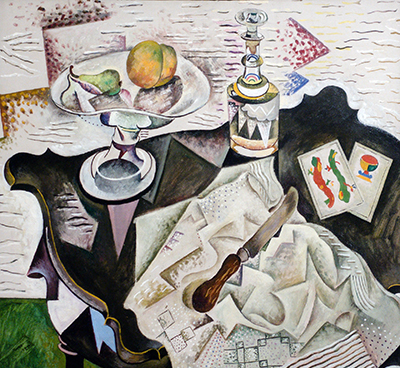Joan Miro produced Spanish Playing Cards in 1920 and it features a number of different objects within a Cubist style, where angle and perspective is altered from reality. The painting now resides at the Minneapolis Institute of Art, USA.
There were certain subjects that Cubists regularly featured within their careers, and table tops was one of those. You will see the same within the work of Picasso, Gris and Braque, for example. Some artists such as Miro and Picasso would produce bodies of work within the Cubist style, as part of a varied oeuvre, where as others like Gris and Braque would actually devote most of their careers to this movement. Upon the table in front of us here we find a fruit bowl with a pear and an apricot. There is also a tablecloth which has been folded and scrunched up, plus a knife with a wooden handle helping to keep it in place. The table itself is of a dark colour with crafted corners helping to identify its period. Elsewhere on the table are a number of small cards with different designs, plus an ornate, transparent bottle with matching stopper.
The artist adds a wall across the back and a small slither of green carpet inorder to set the scene of this artwork. It is a particularly busy artwork, with all elements having visual information incorporated into them. Even the wall itself, whilst beige in colour, has a whole pattern of elements fighting for your attention but somehow the complex piece works well as one. In titling the piece as Spanish Playing Cards, we immediately are drawn to those cards on the right hand side, but they have not actually been given a particularly prominent role within the composition, in terms of how the artist produced a hierarchy of content, of varying significance. Spanish Playing Cards from 1920 is a really important artwork in explaining a body of work from Miro which is sometimes underplayed, and it also reminds us of his relationships with other Cubists and how they influenced his artistic direction for several years.
Joan Miro created a number of still life paintings in 1920 having met several Cubist artists a year earlier. Miro's own approach was a little different and unique to his own tastes, but the mixture of angles ensures that this is entirely in line with the normal characteristics of the overall movement, though within that were a number of different strands of style. All of the items can be identified fairly easily within Miro's approach, but others would amend from reality to such a degree that some objects could not actually be identified as to their original forms. Some might actually have liked Miro's style more, but he did not continue with Cubism for as long as others, meaning we view this part of his career with less focus. In terms of related artworks, you might be interested in the likes of Fruit Dish and Glass and Violin and Pitcher by Georges Braque as well as A Pot of Geraniums and Bottle, Newspaper and Fruit Bowl by Juan Gris.




